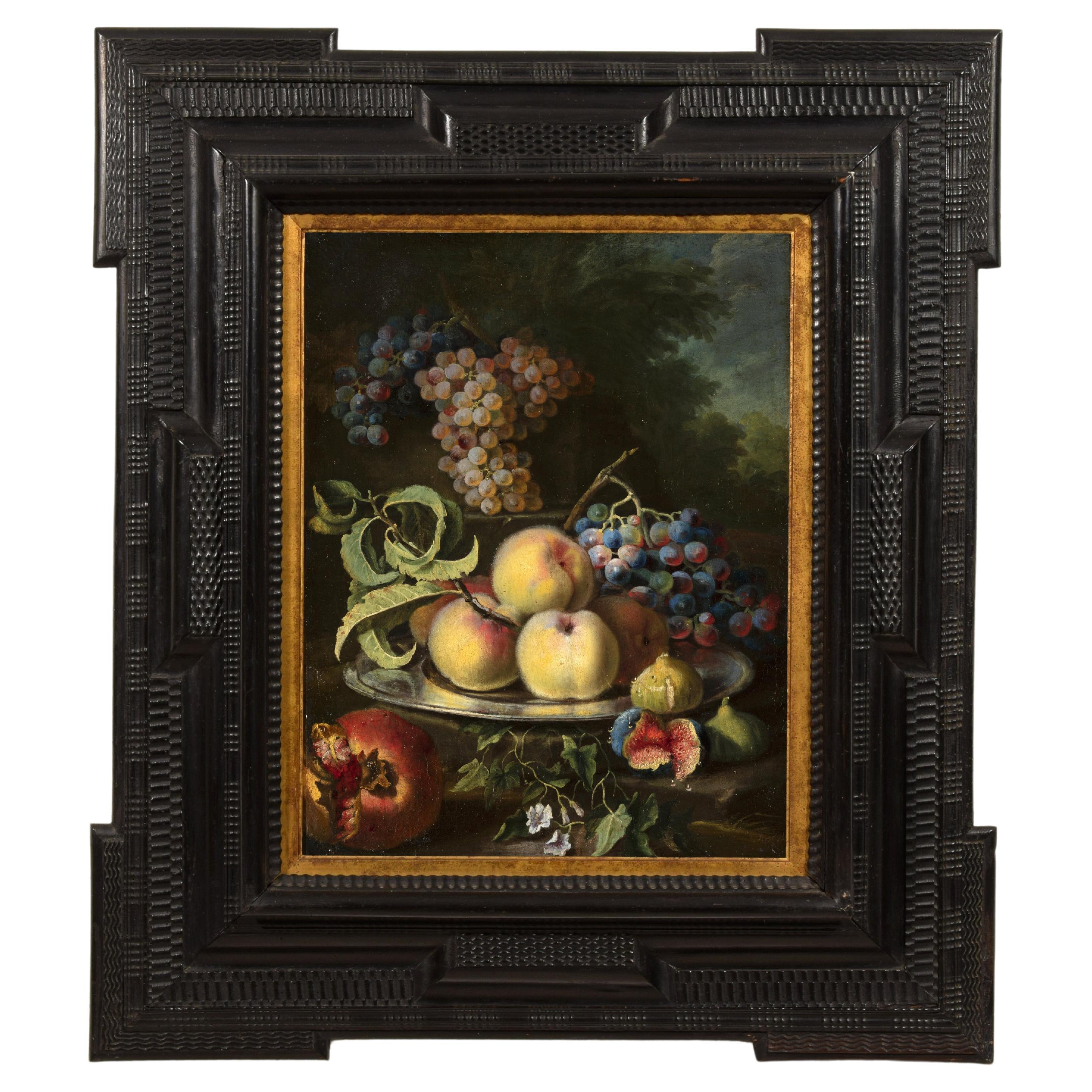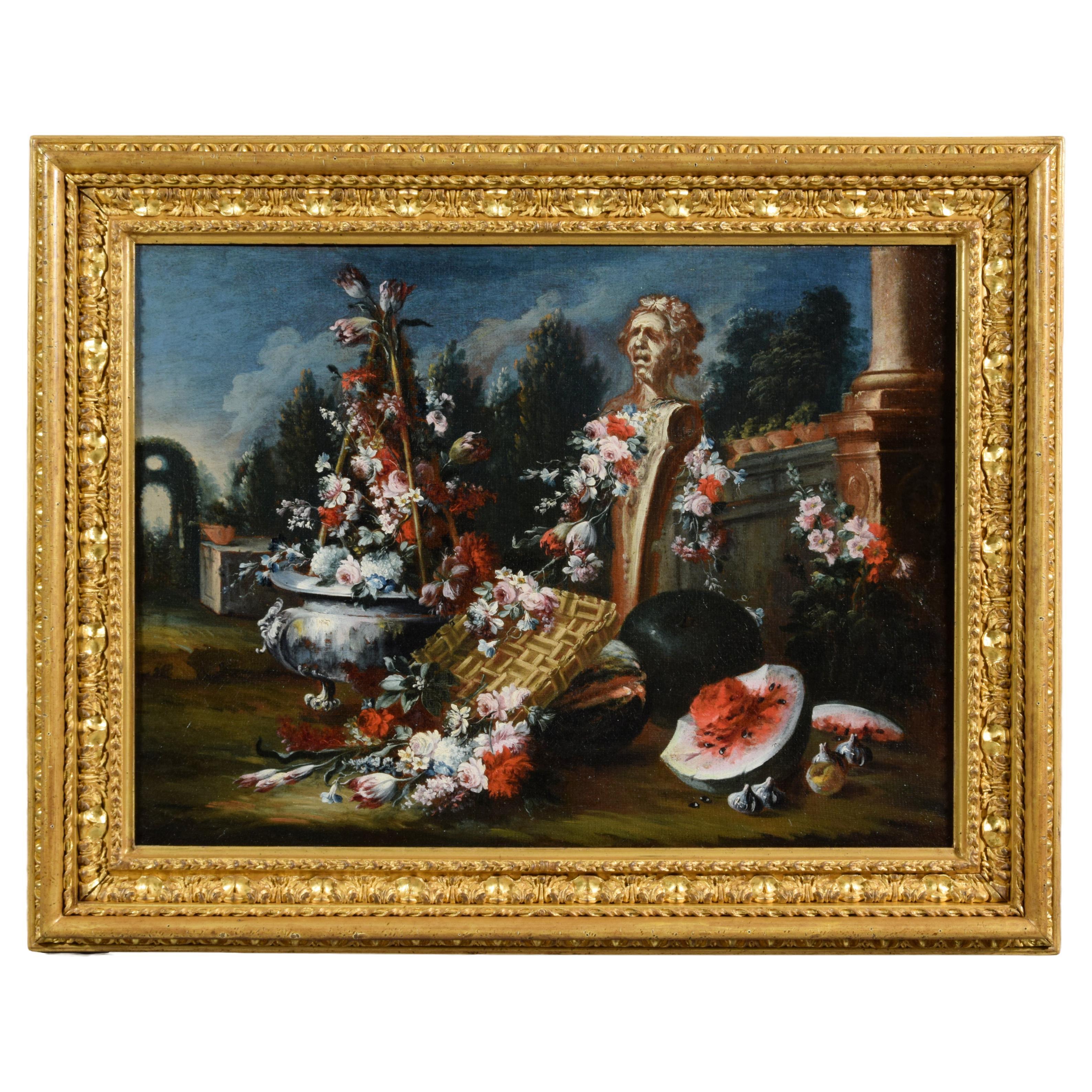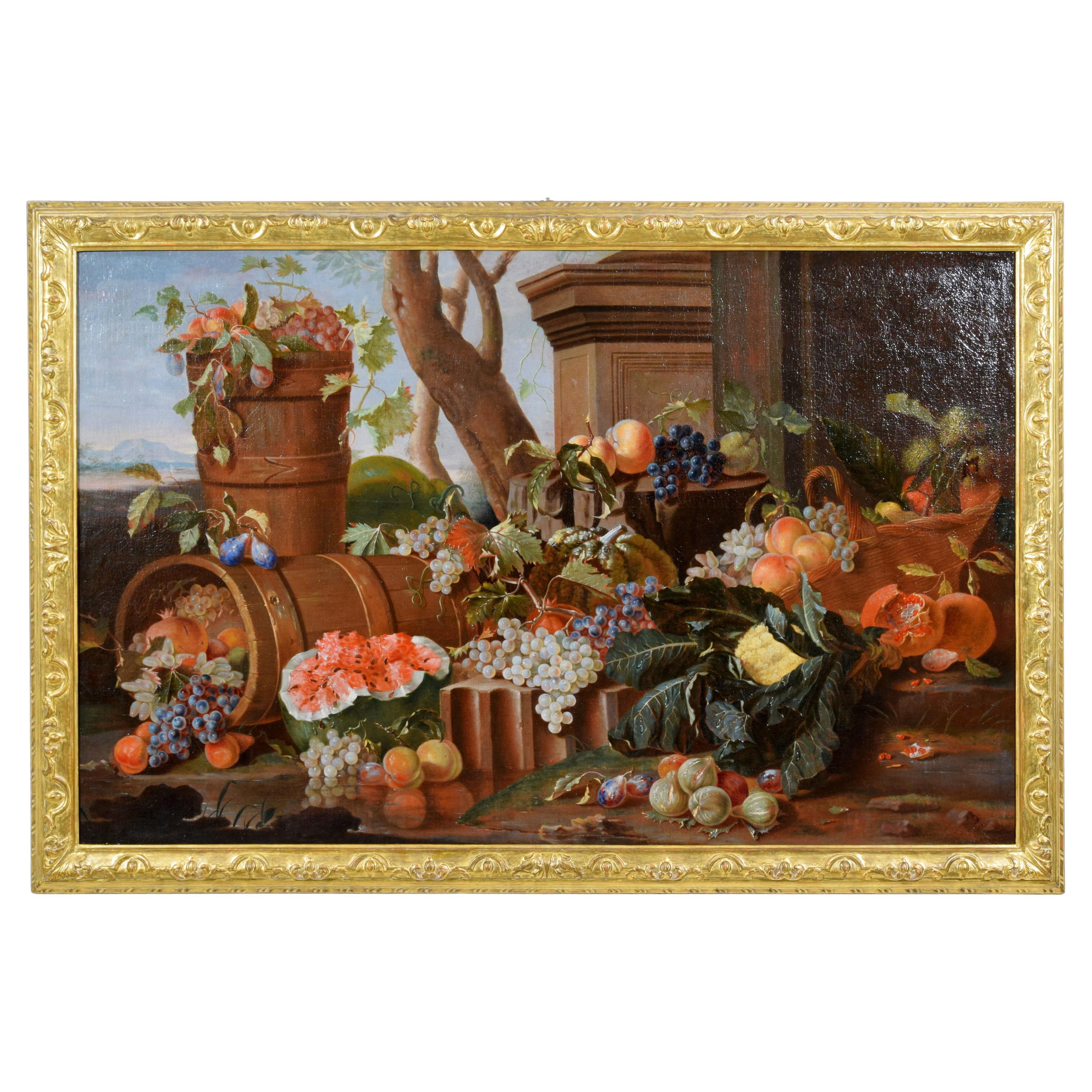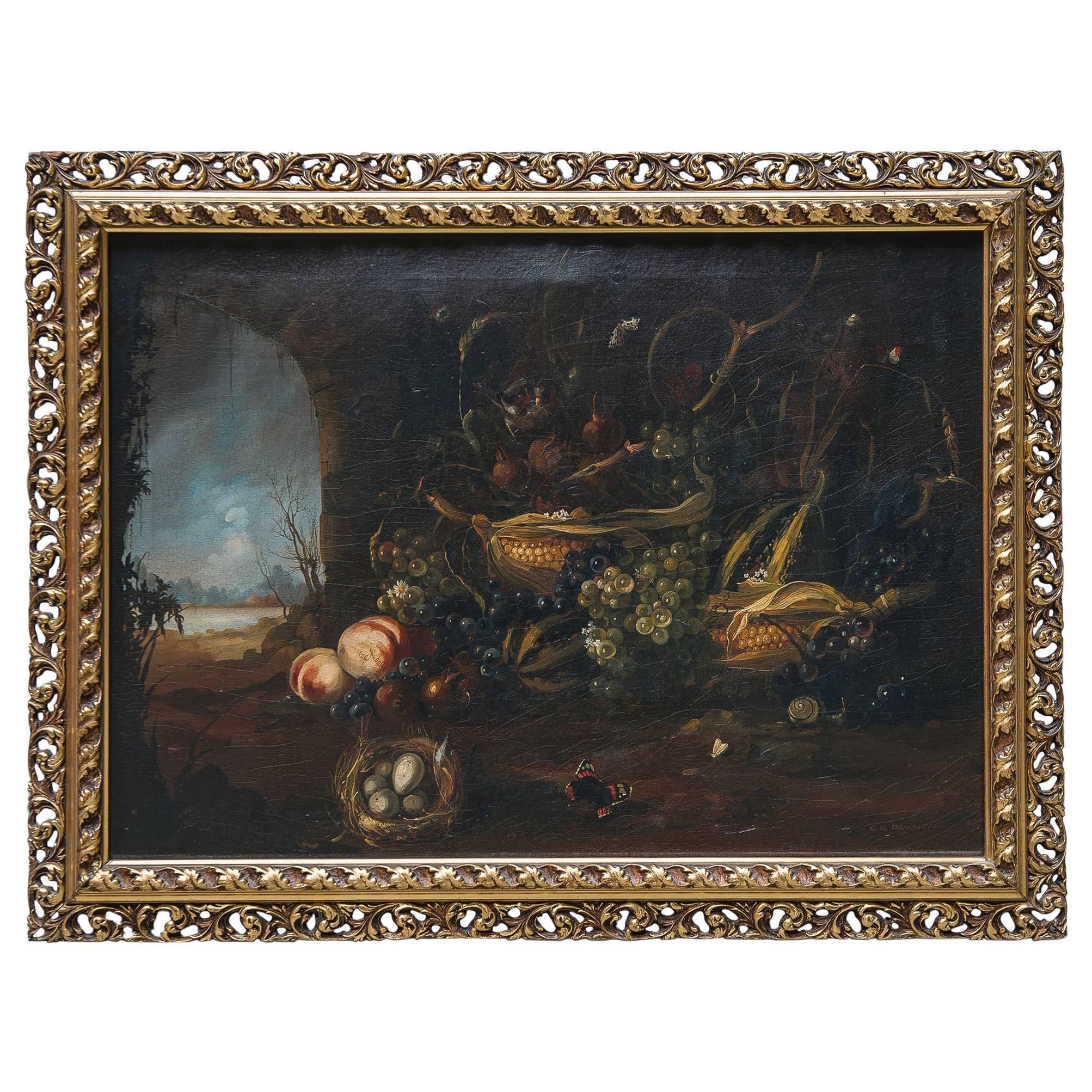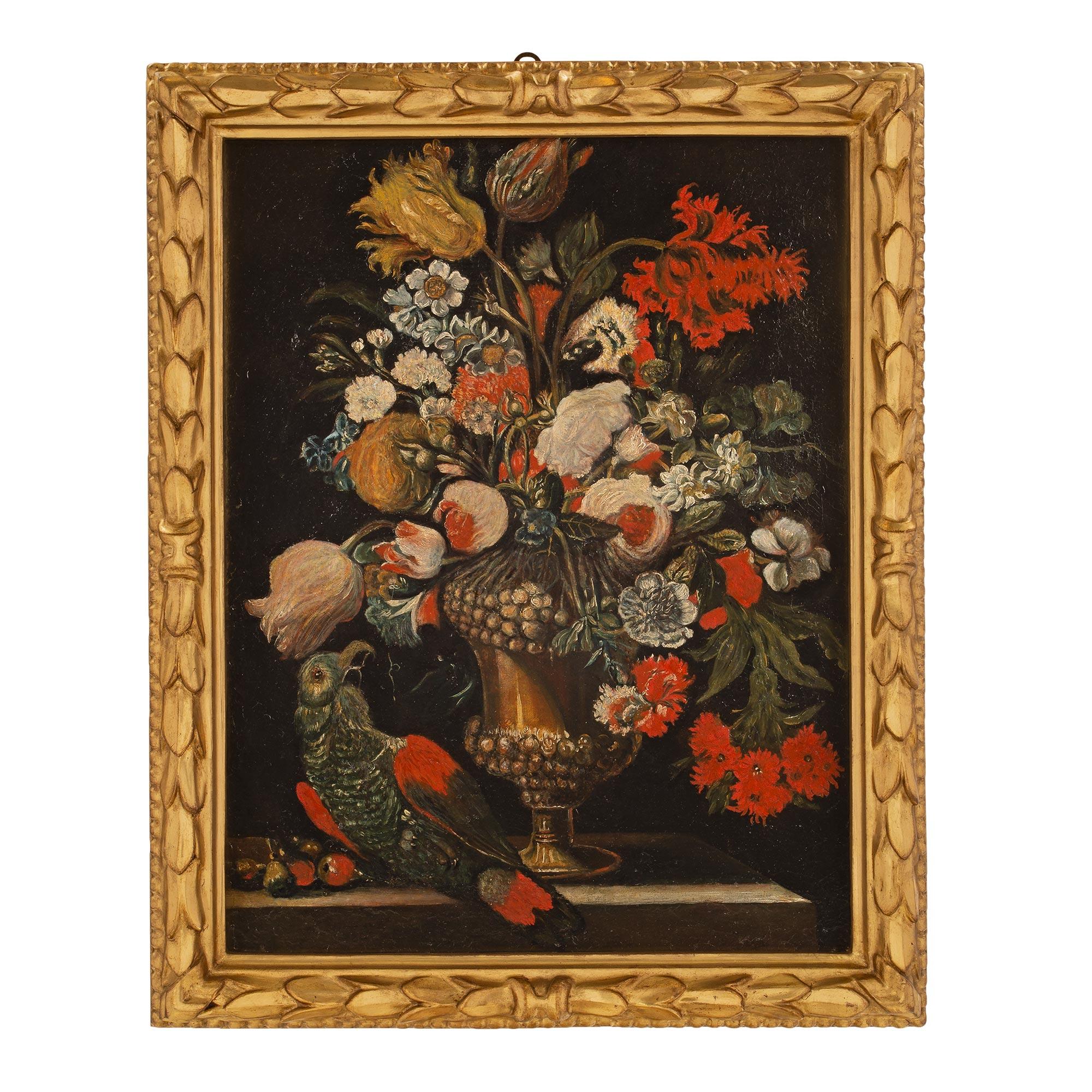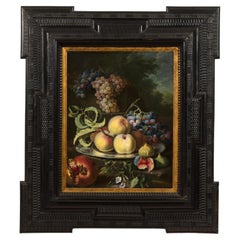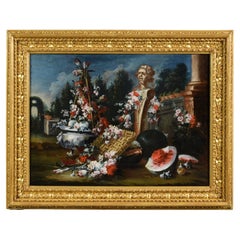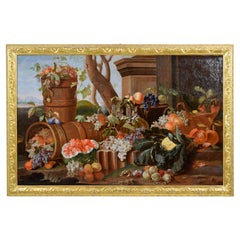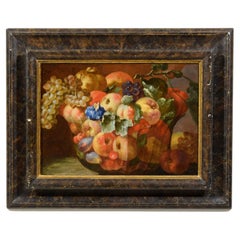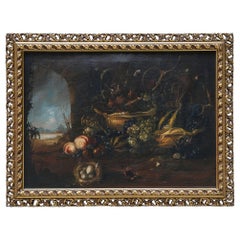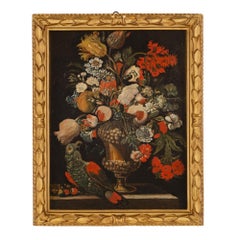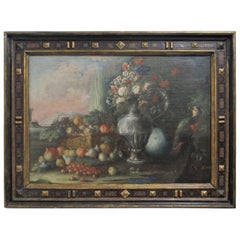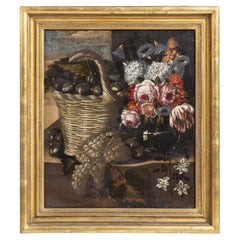Items Similar to 17th Century, Flemish Still Life by Gaspar Peeter de Verbruggen the Younger
Want more images or videos?
Request additional images or videos from the seller
1 of 21
17th Century, Flemish Still Life by Gaspar Peeter de Verbruggen the Younger
$32,948.95
£24,528.35
€27,500
CA$45,131.82
A$50,196.44
CHF 26,211.02
MX$610,837.26
NOK 334,754.73
SEK 313,940.88
DKK 209,347.90
Shipping
Retrieving quote...The 1stDibs Promise:
Authenticity Guarantee,
Money-Back Guarantee,
24-Hour Cancellation
About the Item
Gaspar Peeter de Verbruggen the Younger (Antwerp, 1664 – 1730) and Pieter Ykens (1648 – 1695)
Still Life with Fruit, Flowers, and Female Figure (Flora)
Dimensions: Frame: W 143 cm x H 128 cm x D 8 cm; Canvas: W 21.5 cm x H 106.5 cm
This exquisite oil-on-canvas painting depicts a still life with compositions of flowers and fruit, set in a garden, accompanied by a female figure. Stylistically, the work is attributed to the Flemish painter Gaspar Peeter de Verbruggen the Younger (Antwerp, 1664 – 1730), with the probable collaboration of Pieter Ykens (1648 – 1695).
In the foreground on the right, resting on a surface, is a composition of varied flowers along with peaches, grapes, and a pumpkin. On the left, a young woman holds a terracotta amphora vase filled with flowers in both hands. The maiden, gazing slightly to the right with a gentle turn of her head, has dark brown hair tied with a red ribbon, a pearl necklace illuminating her décolleté, and a lace garment draping her shoulders. A voluminous light-reflecting blue silk stole rests on her arms, creating movement and chromatic variations.
In the background, positioned on a raised architectural element— a sort of stone wall— there is another floral arrangement that winds around the upper architectural element. This vertical development extends beyond the canvas, visually expanding the space. The background suggests an open setting with tall trees, and a glimpse of a blue sky in the upper portion balances the color composition and enhances the scene's three-dimensionality.
The female figure can be identified as Flora, the Roman goddess of spring, flowers, and blossoming.
The painting's artistic quality, style, and composition are comparable to the works of the Antwerp painter Gaspar Peeter (or Pieter) de Verbruggen II, also known as the Younger— one of the leading Dutch floral still-life painters between the 17th and 18th centuries. He was known for his elegant compositions, displaying not only extraordinary talent but also an uncommon botanical knowledge. His works are distinguished by their illustrative monumentality, the opulent depiction of flower petals, and the elegance of his brushstrokes. The painting in question aligns with his body of work, based on critical attributions of many similar pieces in the art market. The artist was known for embellishing his images with garland-adorned vases, following the rocaille aesthetic. Additionally, Verbruggen frequently collaborated with figure painters for depictions of women and playful cherubs. In this case, based on stylistic comparisons, the female figure can be attributed to Pieter Ykens, a talented painter of historical scenes and portraits who also contributed to still lifes featuring elegant female figures as Flora.
Gaspar Peeter Verbruggen (baptized April 11, 1664, Antwerp – buried March 14, 1730, Antwerp) was born in Antwerp to Gaspar Peeter Verbruggen the Elder and his father’s first wife, Catharina van Everdonck. His father was a successful still-life painter, and young Gaspar Peeter grew up in a prosperous household. He became a master in the Antwerp Guild of Saint Luke in 1677-1678, at the age of 13, and was appointed dean of the Guild in 1691. He married Dymphna van der Voort on June 22, 1700, but she passed away shortly after their wedding.
Despite his success, Verbruggen lived beyond his means and was forced to sell all his works in 1703. The proceeds were insufficient to cover his debts, leading him to leave Flanders for the Dutch Republic in 1705. He settled in The Hague, where he received numerous commissions for prestigious residences. He joined The Hague’s Guild of Saint Luke in 1708. However, despite renewed commercial success, his expenses continued to exceed his income. He returned to Antwerp in 1723 and remained active in the Guild until his death in 1730.
Specialized in still life, his broad brushstrokes reflect influences from Italian artists Mario Nuzzi and Michele Pace del Campidoglio. He was also influenced by the French painter Jean-Baptiste Monnoyer. His work contributed to the development of a more decorative style in late 17th-century Flemish still-life painting, inspiring artists such as Jan Baptist Bosschaert, Simon Hardimé, Pieter Hardimé, and Pieter Casteels III.
Verbruggen collaborated with various specialists, including figure painters such as Peter Ykens and Jacob Leyssens in Antwerp, and Matheus Terwesten in The Hague. The Antwerp painter Peeter-Frans Bailliu painted the vases, figures, and grisaille elements in some of his compositions.
Pieter Ykens was born in Antwerp, the son of Johannes Ykens, a sculptor and painter, and his second wife, Barbara Brekevelt. He trained in his father’s workshop and was admitted as a master to the Antwerp Guild of Saint Luke in 1673, later becoming its dean in 1689. He was a painter of religious and historical scenes, portraits, and designed drawings and cartoons for tapestries.
As was common in Antwerp at the time, he frequently collaborated with other painters specializing in specific genres. He worked with Gaspar Peeter Verbruggen the Elder, Gaspar Peeter Verbruggen the Younger, Jan Pauwel Gillemans the Younger, Jan Baptist de Crépu, and Jacob Melchior van Herck, all specialists in still-life painting, as well as with the landscape painter Ferdinand van Kessel.
His female figures are often depicted with pearl necklaces, hair styled in braided updos adorned with ribbons, and voluminous iridescent silk garments.
We apologize for any translation errors from Italian. Please contact us to receive the expertise in Italian.
- Dimensions:Height: 50.4 in (128 cm)Width: 56.3 in (143 cm)Depth: 3.15 in (8 cm)
- Style:Baroque (Of the Period)
- Materials and Techniques:
- Period:Late 17th Century
- Date of Manufacture:Late 17th Century
- Condition:Wear consistent with age and use.
- Seller Location:IT
- Reference Number:1stDibs: LU4405244022662
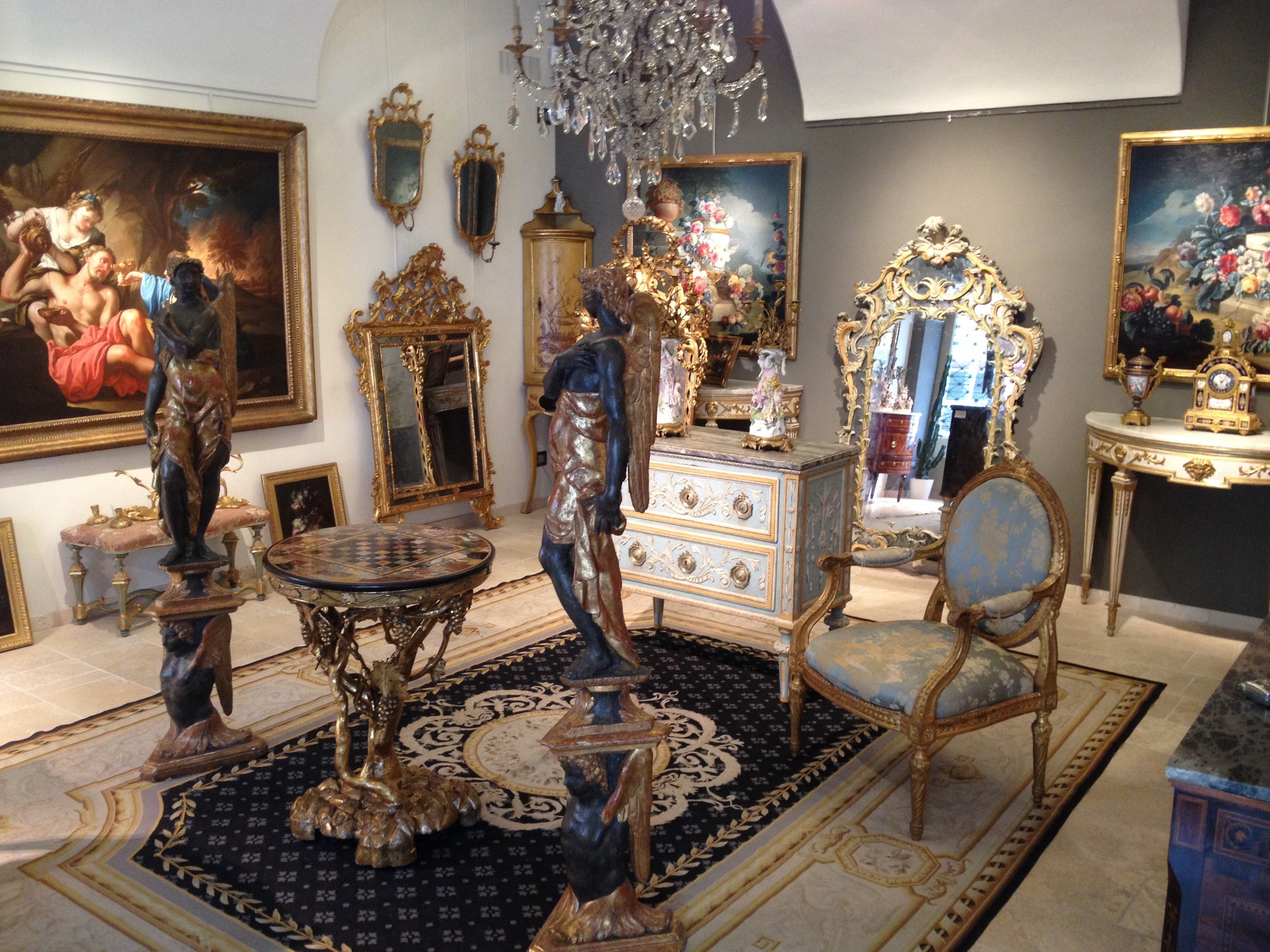
About the Seller
5.0
Platinum Seller
Premium sellers with a 4.7+ rating and 24-hour response times
Established in 1980
1stDibs seller since 2019
56 sales on 1stDibs
Typical response time: 1 hour
- ShippingRetrieving quote...Shipping from: Italy
- Return Policy
Authenticity Guarantee
In the unlikely event there’s an issue with an item’s authenticity, contact us within 1 year for a full refund. DetailsMoney-Back Guarantee
If your item is not as described, is damaged in transit, or does not arrive, contact us within 7 days for a full refund. Details24-Hour Cancellation
You have a 24-hour grace period in which to reconsider your purchase, with no questions asked.Vetted Professional Sellers
Our world-class sellers must adhere to strict standards for service and quality, maintaining the integrity of our listings.Price-Match Guarantee
If you find that a seller listed the same item for a lower price elsewhere, we’ll match it.Trusted Global Delivery
Our best-in-class carrier network provides specialized shipping options worldwide, including custom delivery.More From This Seller
View All18th Century, Painting with Still Life by Maximilian Pfeiler
Located in IT
Maximilian Pfeiler (active Rome, circa 1694-circa 1721 Budapest)
Still life with peaches, grapes, figs and pomegranate
Oil on canvas, Measures: cm H 63,5 x W 47. With frame cm ...
Category
Antique Early 18th Century Italian Baroque Paintings
Materials
Canvas, Wood
18th Century, Italian Still Life Painting Attributed to Francesco Lavagna
By Francesco Lavagna
Located in IT
Francesco Lavagna (Italy -Naples 1684-1724)
"Still life with flowers and watermelon and hermas with garden in the background"
The painting, beautifully made and in good condition, d...
Category
Antique Early 18th Century Italian Baroque Paintings
Materials
Canvas
$17,732 Sale Price
20% Off
18th Century, Italian Oil on Canvas Still Life by Pietro Navarra
Located in IT
18th century, Italian oil on canvas still life by Pietro Navarra
Oil on canvas, canvas measures: cm H 103 x W 164, framed measures...
Category
Antique 18th Century Italian Baroque Paintings
Materials
Canvas
$52,718 Sale Price
20% Off
18th Century, Italian Painting Still Life by Giovanni Paolo Castelli Lo Spadino
Located in IT
Giovanni Paolo Castelli, known as "Lo Spadino" (Rome 1659 – around 1730)
Still Life with a Composition of Fruit
Dimensions: frame cm L 76.5 x H 61 x D 6.5. Canvas cm L 55.5 x H 40
Th...
Category
Antique Early 18th Century Italian Baroque Paintings
Materials
Canvas, Wood
18th Century, Italian Painted with Still Life by Francesco Lavagna
By Francesco Lavagna
Located in IT
18th Century, Italian painted with still Life by Francesco Lavagna.
The fine and imposing painting, accompanied by a frame in carved and gilded wood, depicts a sumptuous composition...
Category
Antique Early 18th Century Italian Rococo Paintings
Materials
Canvas
18th Century, Italian Rococo Still Life Painting by Michele A. Rapos
By Michele Antonio Rapos
Located in IT
Michele Antonio Rapos (Turin 1733-1819), Still life of flowers and fruits,
Oil on canvas
frame: cm H 133 x W 124 x D 8 (canvas: cm 108.5 x 108.5)
The painting depicts a triumph of ...
Category
Antique Late 18th Century Italian Rococo Paintings
Materials
Canvas, Giltwood
$40,257 Sale Price
20% Off
You May Also Like
Italian Still Life Painting Oil on Canvas in Flemish Style
Located in Alessandria, Piemonte
Charming still life old Italian painting with beautiful details, in a vintage Italian carved wooden frame
Interesting for a study room .
If You don't want the frame for the paintin...
Category
Mid-20th Century Italian Baroque Paintings
Materials
Giltwood
Italian 17th Century Still Life Oil on Canvas from Rome
Located in West Palm Beach, FL
A wonderful Italian 17th century still life oil on canvas from Rome. The painting depicts a parrot with fruit at his feet standing next to a vase with a stunning array of colorful an...
Category
Antique 17th Century Italian Paintings
Materials
Canvas, Giltwood
18th Century Italian Still Life Painting
Located in San Francisco, CA
Beautifully executed large-scale still life painting with overflowing fruit, flowers and a parrot. Oil on canvas, in carved, painted and gilt period frame. Signed in lower right corn...
Category
Antique Early 18th Century Italian Paintings
Materials
Canvas
SPANISH SCHOOL 17th Century "Still Life"
Located in Madrid, ES
SPANISH SCHOOL 17th Century
"Still life".
Oil on canvas
Recovered.
Dim.: 65.5 x 55.5 cm.
good conditions
Category
Antique 17th Century Spanish Baroque Paintings
Materials
Paint
Italian 17th Century Oil on Canvas Still Life, from Rome
Located in West Palm Beach, FL
A stunning Italian 17th century oil on canvas still life, from Rome. The painting depicts a beautiful fruit bowl and grapes in the foreground and wonderfully executed bouquet of flow...
Category
Antique 17th Century Italian Paintings
Materials
Canvas, Giltwood
17th Century Oil on Canvas Still Life Painting, in a 19th Century Giltwood Fram
Located in West Palm Beach, FL
An exceptional Continental late 17th century oil on canvas still life painting, in a 19th century giltwood frame. The beautiful painting displays a wonderful array of vivid colors an...
Category
Antique 17th Century Unknown Paintings
Materials
Canvas, Giltwood
More Ways To Browse
Second Hand Pearls
Grapes And Peaches
Pearl Shoulder Necklace
Ribbon And Pearl Necklace
Space Age Necklace
Antique Lace Ribbon
Italian Stone Fruit
Pearl Grapes
18th Century French Necklace
Pace Display Case
Amphora Vase Grapes
Amphora Vase Cherubs
Amphora Holland
Verner Panton Wire
Vintage Indian Silk Fabric
Vintage Metal Blinds
Vintage Metal File Cabinet
Walnut Bedside Cabinets
